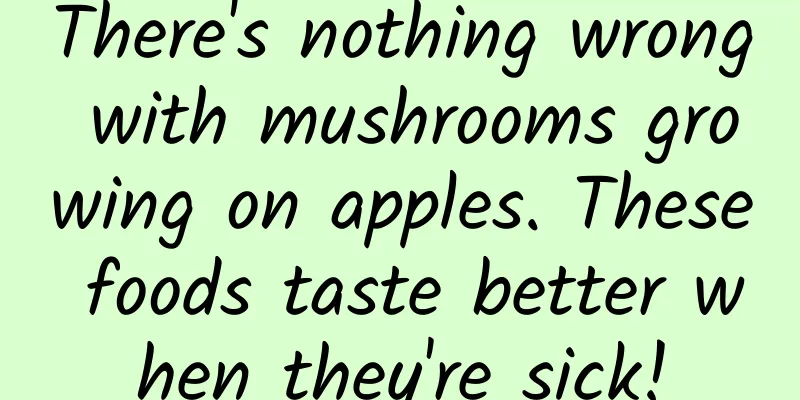There's nothing wrong with mushrooms growing on apples. These foods taste better when they're sick!

|
Some time ago, a netizen on Xiaohongshu posted a photo of an apple with mushrooms growing on it, which attracted the attention of the entire network. The apple was grown with Schizophyllum, also known as white ginseng. Soon, researchers cultivated offspring from this "king of fruit mushrooms" and sent them back to netizens to try. Apples grow mushrooms. Click on the picture to see the story of the "Fruit Mushroom King"|Xiaohongshu: @🍀沛容 Although it seems outrageous that mushrooms grow on apples, in fact, some common foods in daily life are also obtained after normal ingredients become "sick" . Mushrooms aren’t the only things that grow on trees In most cases, people try to keep crops healthy and prevent them from being infected by pathogens. But someone started experimenting with sick food and developed a way to cultivate "sick" food. A well-known example is wild rice stems . The wild rice stems we eat are the swollen stems of wild rice ( Zizania latifolia ) infected by wild rice smut fungus ( Ustilago esculenta ). Wild rice stem | Micromesistius / Wikimedia Commons Zizania is an aquatic plant. Before infection, its stems are about the same thin as those of its relatives in the grass family, such as rice. But once infected by smut, the fungus secretes substances that make its stems continue to swell , turning it into delicious wild rice. Once infected with smut, Zizania cannot produce seeds, but fortunately they can still reproduce asexually through their roots. The history of artificial cultivation of wild rice has been more than 2,000 years. In addition to the ones we usually eat, there are two types of water chestnuts grown in the fields that are not suitable for consumption: one is called gray water chestnut , which contains a large number of winter spores and may cause allergic pneumonia; the other is male water chestnut , whose rhizome does not swell and will bloom and produce wild rice, and is also not suitable as a food ingredient. There is no swelling of Zizania latifolia, which looks completely unrelated to Zizania latifolia | Forest and Kim Starr / flickr Ustilago smut is also known as kaoliang umami in the north. Although it has the word "umami" in its name, it is actually a mushroom that grows from sorghum ears. Friends in the northeast may be more familiar with it. When sorghum is infected with the sorghum head smut fungus ( Sporisorium reilianum ), the ears will be occupied by mycelium and will not only fail to produce fruit normally, but will also turn black, forming "black sorghum". Sorghum head smut is one of the main diseases of sorghum, which can cause serious yield losses; however, in order to obtain black sorghum, humans have carefully selected susceptible varieties so that sorghum can survive the disease. Not only do some areas grow sorghum just for the purpose of harvesting black rice, but researchers have also developed derivative products such as bread, beverages, and noodles made from black sorghum. Sorghum umami is actually the fruiting body of a fungus, so sorghum umami can also be seen as a mushroom growing in a sorghum ear. Sorghum head smut is harmful to the growth and reproduction of sorghum, but it has long been classified as an edible fungus. This is also true for many edible fungi, which are delicious to humans but also pathogens of plants. Ganoderma lucidum, shiitake mushrooms and black fungus are typical wood-rotting fungi. When such fungi appear on tree trunks, it often indicates that the life of the tree is beginning to decline, or has come to an end. It is quite common to see mushrooms growing on wood, but it is much rarer to see mushrooms growing on bamboo. Scorias spongiosa is a pathogenic fungus of bamboo. When bamboo is infected with it, it will grow a fruiting body that looks like both white fungus and bird's nest. In Sichuan, the mushrooms grown on this kind of bamboo are called bamboo bird's nest fungus, bamboo flower fungus, bamboo bird's nest, and stone flower fungus. As a rare edible bamboo fungus, its artificial cultivation has also been put on the agenda. Bamboo bird's nest丨He Xinsheng, Liu Chaoyang, Lin Qi, et al.[12] Bugs can also grow mushrooms Not only plants can be turned into food after being infected with fungi, but animals can also be turned into food, the most famous of which is Cordyceps sinensis. Cordyceps sinensis is a fungus that usually parasitizes the larvae of the bat moth family. They absorb nutrients from the larvae until the larvae die, and then they "break out" - the larvae corpse and the bursting fungus together form a complete cordyceps. Cordyceps sinensis|Gross Science / youtube Cordyceps sinensis has a limited distribution range, and its wild resources are scarce. Due to over-exploitation and climate change, its number has declined. It has been listed as a national second-class protected species . The artificial cultivation of Cordyceps sinensis is a major research hotspot for scientists. Once artificial cultivation is successful, it can not only protect wild resources and relieve environmental pressure, but also satisfy people's curiosity to try new things. However, this is not easy. Not only do we have to raise both insects and bacteria, but we also have to figure out how to inoculate the bacteria into the insects. In addition to the well-known Cordyceps sinensis, Cordyceps militaris , C. chanhua and C. guangdongensis are also medicinal and edible fungi. Cordyceps militaris, also known as Cordyceps flower and Cordyceps sinensis , is formed when the Cordyceps flower fungus parasitizes on the larvae of Lepidoptera. It has been on the tables of ordinary people for many years and is a common ingredient for making soup. The Cordyceps flowers commonly seen on the dining table are also formed by insects parasitizing plants|Picture insect In addition to being delicious, the unique habit of Cordyceps fungi that parasitizes insects also makes them ideal for pest control . Scientists have discovered dung beetle Cordyceps ( C. geotrupis ) that specifically parasitizes dung beetles. Perhaps one day in the future, scientists will also be able to discover cockroach Cordyceps and use it to control the frequency of cockroaches. “Spoiled” food is actually very common Plants and animals that grow mushrooms may seem a little scary, but moldy food is much more common. Thanks to our ancestors' waste recycling, we have ingredients such as moldy tofu, fermented tofu, yogurt, cheese, vinegar and bean paste. The production process of these ingredients is inseparable from fermentation, and during the fermentation process, it is the fungi, bacteria and other microorganisms that change the color, aroma and taste of the food , producing a unique flavor that is irresistible. Different bacterial flora and fermentation processes create a variety of cheeses with different flavors|Pixabay For example, when the Mongolians use wooden barrels to naturally ferment cheese , bacteria and fungi are busy. The bacteria involved in this labor include Lactococcus, Lactobacillus and Acetobacterium, etc.; the main fungi are Geotrichum, Issaffine and Kluyveromyces. These microorganisms implement a "shift system" during the cheese fermentation process - at first, the bacteria are the most active, and as the cheese gradually matures, the participation of fungi gradually increases. The differences in bacterial flora and fermentation processes give various cheeses unique flavors and tastes. For example, Lactococcus, Lactobacillus, Kluyveromyces, Geotrichum and Pichia are all microorganisms with a high correlation with cheese flavor. Of course, fermented products are not always fragrant. There may also be foods like stinky tofu that smell bad but taste good. To find the source of this unique flavor, we must observe the traces of microorganisms left in the brine used to make these foods. Stinky tofu is made through natural fermentation, and its flavor is easily affected by the environment|Pixabay Stinky tofu is made through natural fermentation , that is, fermentation using bacteria existing in nature. This production method is also called "open fermentation". Therefore, stinky tofu in different regions will also show differences in production process and flavor. For example, Changsha stinky tofu, which is eaten fried, and Shaoxing stinky tofu, which is eaten steamed, show obvious differences in appearance and flavor. Although they are both called stinky tofu, they are not the same. When cheese is fermented, fungi contribute a lot to color and flavor; while in the stinky tofu brine and raw embryo, bacteria contribute more to flavor, so stinky tofu has a lot of odor, but almost no moldy smell. Thanks to the development of the food manufacturing industry, factory-produced fermented foods such as yogurt and vinegar already have stable flavors and sufficient production. However, foods obtained through natural fermentation often have unstable flavors because their microbial composition is easily affected by environmental changes. After all, each fermentation process is like inserting a coin into a capsule machine, and there is no way to determine what the final result will be. The tears of trees can also be eaten In addition to mold and mushrooms, some other plant diseases may also produce delicious food. For example, peach gum , which is common in sugar water, is the "tears" produced by peach trees after being stimulated by external factors, such as drastic changes in temperature or being injured (gnawed by insects). Although no mushrooms grow, peach gum is also a symbol of the tree falling into "sub-health" or even illness. Peach gum|TuChong Peach gum can be divided into broad and narrow concepts: broad peach gum refers to the gum secreted by the trunks of Rosaceae plants (such as peach trees, almond trees, cherry trees, apricot trees, and plum trees); narrow peach gum refers only to the gum secreted by peach trees, excluding other tree species. In terms of processing, peach gum can be divided into raw peach gum and commercial peach gum: raw peach gum has fewer processing steps and is usually used for food; commercial peach gum requires fine processing of raw peach gum, and its uses are more extensive, including medicine, cosmetics, inks, and even electronic industries. So, do peach trees that produce peach gum still produce peaches? The answer is yes, but they may not grow as much as they should. At present, people have not figured out how to effectively "torture" peach trees; on the contrary, when peach trees produce a lot of peach gum, management methods need to be adjusted to prevent the outbreak of peach tree diseases and insect pests . When peach gum is produced in large quantities, peach trees will not produce many peaches|Pixabay Putting "sick" foods on the table may have been originally just a matter of livelihood and thrift. But today, they have become special delicacies, and people even cultivate special varieties or mass-produce them. Isn't this unique delicacy the crystallization of wisdom accumulated by generations? References [1] Li Wenjia, Dong Caihong, Liu Xingzhong, Li Quanping, Xia Jinming, Liang Lei. Research progress on Cordyceps sinensis cultivation technology[J]. Journal of Mycology, 2016, 35(4): 375-387 https://doi.org/10.13346/j.mycosystema.160003 [2] Chen Wanhao, Liang Jiandong, Han Yanfeng, Zou Xiao, Zhang Yongjun, Liang Zongqi. A review of the past and present of Cordyceps (fungi)[J]. Mycological Journal, 2021, 40(11): 2894-2905 doi:10.13346/j.mycosystema.210164 [3] Zhu Zhe. Effects of different sowing periods on sorghum yield and traits[J]. Agricultural Development and Equipment, 2023(5):150-151. DOI:10.3969/j.issn.1673-9205.2023.05.048. [4] Li Lifeng, Wang Xiaohe, Shi Taiyuan, et al. Research and development of sorghum black rice noodles[J]. Liaoning Agricultural Science, 2008(1):21-23. DOI:10.3969/j.issn.1002-1728.2008.01.007. [5] Yu Miao, Sun Dawei, Shi Taiyuan, et al. Research and development of sorghum and black rice bread[J]. Food Research and Development, 2014(12):33-35. DOI:10.3969/j.issn.1005-6521.2014.12.010. [6] Zhang Rui, Shi Taiyuan, Yu Tianying, et al. Research and development of sorghum glutinous rice beverage[J]. Freshness and Processing, 2008, 8(5):42-44. DOI:10.3969/j.issn.1009-6221.2008.05.015. [7] Xiang Yanru, Li Zudi, Chen Jianwei. Research on the properties, processing and components of raw peach gum and its application in food and medicine[J]. Food Industry Science and Technology, 2019, 40(19): 321-325. DOI:10.13386/j.issn1002-0306.2019.19.056. [8] Liang Zongqi, Liu Aiying, Huang Jianzhong. Some entomogenous fungi in Wuyishan and Zhangjiajie Nature Reserve I. Cordyceps[J]. Mycosystema, 2002, 21(2): 162-165. DOI: 10.3969/j.issn.1672-6472.2002.02.003. [9] Liu Min, Lin Jiawei, Jiao Yuwei, et al. Analysis of the diversity of Mongolian traditional cheese microbial flora based on high-throughput sequencing technology[J]. China Brewing, 2024, 43(3): 116-120. DOI: 10.11882/j.issn.0254-5071.2024.03.018. [10] Gu Jingsi, Hou Juan, He Guoqing. High-throughput sequencing analysis of bacterial species diversity in stinky tofu[J]. Journal of Chinese Institute of Food Science and Technology, 2019, 19(3): 250-255. DOI: 10.16429/j.1009-7848.2019.03.032. [11] Shrestha B, Tanaka E, Hyun MW, et al. Coleopteran and lepidopteran hosts of the entomopathogenic genus Cordyceps sensu lato[J]. Journal of Mycology, 2016, 2016(1): 7648219. [12] Peng Hui, Yao Lianghong, Zhang Zhen, et al. Purification of Zizania latifolia seedlings based on detection of T-type smut fungus[J]. Journal of Agricultural Biotechnology, 2023, 31(8): 1757-1766. DOI: 10.3969/j.issn.1674-7968.2023.08.018. [13 He Xinsheng, Liu Chaoyang, Lin Qi, et al. Molecular identification of the large-scale pathogen of bamboo soot disease - Sooty mold of sponge bamboo[J]. Journal of Fujian Forestry College, 2011, 31(4): 363-367. DOI: 10.3969/j.issn.1001-389X.2011.04.016. [14] He Xinsheng, Liu Chaoyang, Zheng Junjuan, et al. Pure culture of the fruiting body of the bamboo edible mushroom, Aglaonema spongiosum[J]. Journal of Bamboo Research, 2012, 31(1): 18-22. DOI: 10.3969/j.issn.1000-6567.2012.01.005. [15] Lin Qunying, Li Taihui, Song Bin, et al. Comparison of components of Cordyceps sinensis, Cordyceps sinensis and Cordyceps militaris[J]. Journal of Edible Fungi, 2009, 16(4): 54-57. DOI: 10.3969/j.issn.1005-9873.2009.04.014. [16] Li Zengzhi, Luan Fenggang, Hywel-Jones Nigel L, et al. Research on the biodiversity of Cordyceps fungi related to Cicadae fungi II: Discovery and naming of the sexual form of the important medicinal fungus Cicadae fungi [C]. // Proceedings of the 3rd China Youth Academic Forum on Lichen Biology. 2020:95-107. Author: Cod Editor: Mai Mai |
>>: In the eyes of children, it is "scoring points like crazy" in the deep sea
Recommend
Today’s College Entrance Examination丨The “fruits” are ahead, pick them bravely!
Today is the first day of the national college en...
Introduction to frequently used iOS third-party libraries and XCode plug-ins
Third-party libraries are something that programm...
Taking advantage of the momentum of "Ode to Joy 2", why is JD.com the only one to dominate the screen?
I know that half of my advertising dollars are wa...
In-depth | In 2019, which marketing trends will kill you?
As usual, I list my guesses about the marketing t...
How to promote brands on Bilibili | 6000-word strategy analysis
This article mainly aims to solve two problems: 1...
Only 3 tricks are needed to attract traffic and promote Xiaohongshu!
Xiaohongshu App is hailed as a magic tool for you...
3 questions and 5 steps to help you create a successful online event
When doing an online event, we often feel uncerta...
Amazing! The colored lights in the field actually hide such a big secret?
When we walk along the country roads, we sometime...
From the Father of Android to the Voice of Rock, why did those mobile phone brands that started off strong but ended up failing?
The phrase "start high and end low" is ...
When a female corporate executive steals clothes from a shopping mall, is this kleptomania?
Recently, Guanghan police arrested a young woman ...
Whether the nail clippers are “flat” or “round” actually affects whether you get paronychia?
Audit expert: Zhang Yuhong Chief Physician of Der...
Bad bacteria are causing trouble for medical treatment? Stop them with antibacterial coating!
In order to thoroughly implement the "Outlin...
Spend 2 hours writing every day, Zhihu Good Things can also make a lot of money part-time, actual monthly income exceeds 30,000+
Spend 2 hours writing every day, Zhihu Good Thing...
Learn these 8 "head to toe" health self-test methods to teach you to check yourself in time to eliminate health risks
Many people's lives I've been a bit hecti...
Where does the extremely destructive sand surge come from?
recently Affected by the 6.2-magnitude earthquake...









